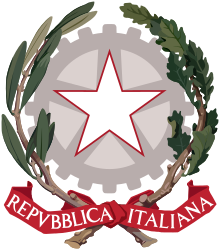Stella d'Italia

The Stella d'Italia or (colloquially) the Stellone d'Italia (in English "Star of Italy" or "Big Star of Italy") is one of the oldest national and state symbols of Italy . Today the star of Italy is often associated with the Italia turrita , the female national allegory of Italy crowned with a wall crown (Corona Muralis) . The star itself has also developed into a national allegory of Italy. The star of Italy is five-pointed, symmetrical and white.
origin
The myth of Stella d'Italia dates back to the sixth century BC, the time of the Sicilian poet Stesichorus back, who in his work Iliu persis ( "The destruction of Troy") the legend of Aeneas writes down, following the destruction of Troy by the Greeks return to Italy, the land of his ancestors.
The legend of Aeneas' journeys across the sea to the Italian coast, guided by the evening star of his mother Venus (Stella Veneris) , was taken up in later times by Marcus Terentius Varro and Virgil , who thus laid the foundation for the political tradition of Caesaris Astrum as well as for the designation of Italy as Esperia , after the Greek Hesperos (evening star). Both motifs ultimately relate to the astral-mythological figure of Venus, which is understood on the one hand as the pioneering evening star that defines Italy as the land of the evening red , on the other hand, as the divine personification of love, gave birth to the Roman-Italian national hero.
Symbolic meaning of the star
Until the Risorgimento , the symbol of the star was associated with Leonardo da Vinci's motto Non si volta chi a stella è fisso , which translates as meaningful if you are like a fixed star, you cannot bend . After the Italian unification , the meaning changed more and more to the Stellone as the protector of Italy , among other things through the massive use of stars by King Victor Emmanuel II on official occasions . The change to the star as a protective symbol continued in the post-war years from 1919 to 1924 and has continued to this day. In 1947 the artist Paolo Paschetto designed the coat of arms of the modern Republic of Italy , the central motif of which is the star.
The star and the national allegory
In 1603 Cesare Ripa assigned the star of the Italia turrita in the second edition of his work Iconologia and thus created a modern version of the Italian national allegory: a woman crowned with a star (L'Italia turrita e stellata) . Ripa's work influenced artists such as Antonio Canova , Bisson, Cesare Maccari , Giacomo Balla , Mario Sironi and many others until the first decades of the 20th century. The portrait of the Italia turrita became more and more popular during the Risorgimento period. A large number of statues, friezes , decorative objects, postcards and magazines showed the portrait of the Italia turrita with the Corona Muralis and the Stella Veneris .
The Italian patriot Giuseppe Mazzini , and later Camillo Benso von Cavour and the House of Savoy , also invoked Aenea's trip and the star to evoke the national unity of Italy. The royal house even tried to adopt the myth of the star for themselves by establishing a connection with the Stella Sabauda , a heraldic symbol in the Savoy family coat of arms, but its use is not documented before Italian unification.
Italia turrita e stellata at the Zenotaph Dante Alighieris in the Church of Santa Croce in Florence (left statue with wall crown and star)
Francesco Liberti, L'Italia turrita e stellata (Eng. Italia with wall crown and star), 1861, Palazzo Reale in Naples ; the star of Italy is on the top of the wall above the forehead
Monument in Quarto dei Mille in memory of the train of the thousand
Bow of the Andrea Doria with the star as a figurehead
Activity stars on Italian uniform collars represent the star of Italy
20 Lire coin from 1882 with the star of Italy on top
See also
- Italia turrita
- State symbols of Italy
- Coat of arms of the Republic of Italy
- Order of the Star of Italy
- Colonial Order of the Star of Italy
literature
- Giovanni Lista: La Stella d'Italia . Edizioni Mudima, Milan 2011, ISBN 978-88-96817-06-3 (Italian).
Web links
Individual evidence
- ^ Un simbolo per la Repubblica , website of the President (Italian); accessed on November 25, 2018








